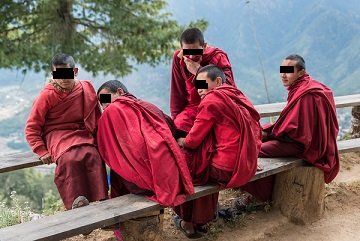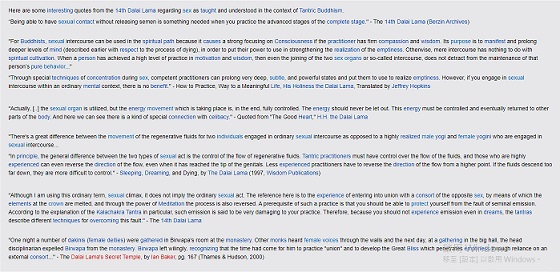| 首页 » » 双身法喇嘛教(西藏密宗、伪藏传佛教)秘密大公开 |
藏密流毒所及,南传淫风四起(一)——不丹为僧侣发放安全套 |
引言: 无论何方世界、地域大小,当地佛门修行人的德行皆为所在地的标杆,若值遇高僧弘化一方,那真是当地百姓的福分。且不谈是否发成佛的大愿,佛门修行人至少是以清净自心、持戒而守护身口意行,以善法自利利他的。因此,这一身僧服穿上身,便可得众生恭敬和供养。 西藏密宗以印度教性力派谭崔的实质,打着佛教的旗号,十八世纪以来,在全球散播谭崔性力派的修法,不独独令欧美的白种人误以为藏密就是佛教、佛教最高秘法修行就是性交,且在以尊崇佛教以南传佛法闻名的东南亚,亦显现淫欲之风取代真正二乘清净修行的大趋势。 尤其达赖喇嘛外逃西藏之后,藏密流毒在全球更加肆虐。老淫魔已经公开教男童吮舌了,再结合喇嘛教的谭崔秘传教法,他私下淫欲行为无论被如何猜测,都是合理怀疑、毫不过分。FPMT(捍衛大乘傳統聯合會)是达赖喇嘛及其党羽在南洋成立的机构,于法义上散播不分别和法界没有因果的应成派中观大邪见,于实修上私下传播交合之术。既然没有解脱的功德受用,又认为没有因果报应,年轻且生理欲望旺盛的僧侣们见学藏密的师父可以披着僧衣享齐人之福,自己又何必要持守佛门清规呢?交相呼应之后,于是南传佛法如今乌烟瘴气。 请注意: 若南传佛教僧侣的淫乱为偶发事件,则是僧侣个人修行、私德问题; 当南传佛教僧侣的淫乱事件变成此起彼伏、令当地原本尊崇佛教的信众鄙视和厌恶之时,已经不是简单的个人私德问题,而是藏密谭崔性力邪教流毒所导致。 佛教修行人所到之处以德服人,而藏密淫乱之风所到之处,最终的结局都是令众生唾弃! 请勿玷污尊贵的 佛和佛法! 请勿戕害众生法身慧命! 不丹卫生机构为僧侣发放安全套
发放了这个:
出家? 安全套? 百思不得其解中...... 这个月是 Saga Dawa的神圣月份,数以百万计的佛教徒在这一天庆祝佛陀在 2500 多年前的诞生丶成道和涅盘(圆寂)。 具有讽刺意味的是,据报道,同月,在佛教小国不丹,卫生部门正在向所有佛教寺院学校提供避孕套,以阻止性传播疾病和艾滋病毒在本应是独身佛教徒的年轻僧侣中传播。 无论如何,无论人们如何看待自愿成年僧侣之间的“大腿性行为”,如果他们感染了艾滋病毒和其他性传播疾病,这通常意味着完全插入性行为(与男性或女性); 插入性行为明显违反了他们的誓言和佛陀关於寺院纪律和道德的教义。
英文原文: Bhutan Issues Condoms for Monks This month is the sacred month of Saga Dawa, when millions of Buddhists celebrate the Buddha’s birth, enlightenment and parinirvana (passing away) over 2500 years ago. Ironically, this same month, in the tiny Buddhist kingdom of Bhutan, it was reported that health authorities are making condoms available at all Buddhist monastic schools in a bid to stem the spread of sexually transmitted diseases and HIV among young monks who are supposed to be celibate. According to one newspaper, warning signs of risky behavior among monks first appeared in 2009, when a report on risks and vulnerabilities of adolescents revealed that monks were engaging in “thigh sex” (in which a man uses another man’s clenched thighs for masturbation), according to the state-owned Kuensel Daily. On the one hand,this is a shocking story about the moral degeneration of the Buddhist community, with supposedly celibate Buddhist monks engaging in sexual activity. On the other hand, it is a positive sign of a conservative, Buddhist society opening up and acknowledging there is a serious problem of sexual misconduct in their monastic institutions. The point of taking monastic celibacy vows is to show one’s commitment and intention to renounce attachment to sexual desire that, from the Buddhist viewpoint, causes many different types of physical and mental suffering. Some might think “thigh sex” (if consensual) is a minor transgression. Yet, one might also question if this was really what the Buddha intended when he spoke about the path of celibacy? In any case, whatever one might think about “thigh sex” between consenting adult monks, if they are contracting HIV and other STDs, that generally means full penetrative sex (with men or women); penetrative sex is a clear breach of their vows and the Buddha’s teachings on monastic discipline and ethics. Over the last few years, I have heard several stories of monastic sexual misconduct and abuse in Tibetan monasteries in exile. At times it is difficult to distinguish what is second-hand gossip and what is based on facts or direct personal experience. Melvyn C. Goldstein also referred to the sexual activity of monks in his book History of a Modern Tibet (Vol 2) and Lama Shree Narayan Singh has also written about the historical origin of ‘thigh sex’ in Tibet; however, up until recently, very few Tibetans have taken the brave step of ‘going public’ with their personal experiences. |
| 首页 |




